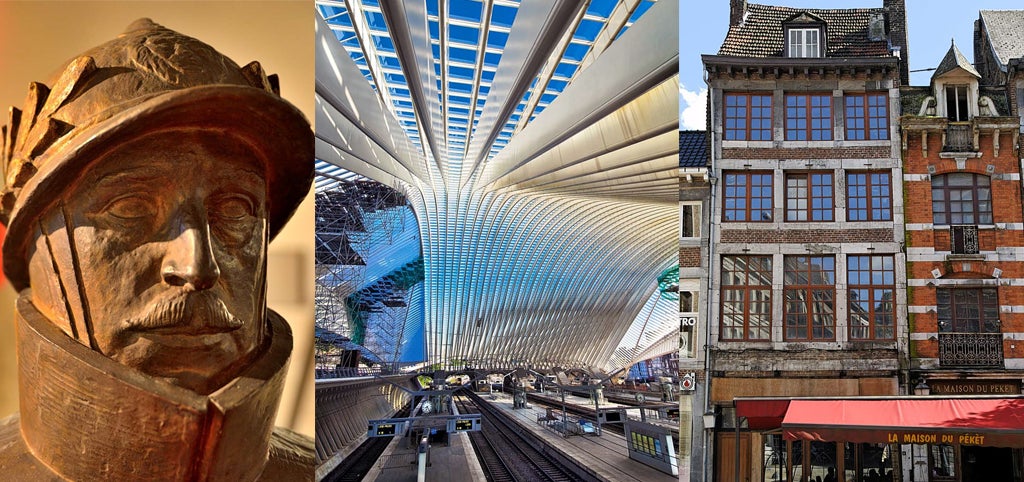Liege: A proud history to explore
Make like a local and enjoy Liège’s diversity – from inspiring architecture to great nightlife. By Cathy Packe

Enlightened, ecclesiastical and elegant: Liège has a proud history as a medieval city, and for a time was one of the richest and most powerful places in Europe. So the striking concrete and glass railway station comes as a surprise. Intended to look like a woman lying on her side, to many it resembles a baseball cap – rounded at the southern end and with a peak to the north. Liège-Guillemins (named after the square that the station dominates) provides an excellent overture for the modern changes that are being brought to this ancient city.
Santiago Calatrava, who designed the station, is not the only renowned architect to come to Liège. Ron Arad has designed the Médiacité shopping mall. The French architect Rudy Ricciotti is transforming the Palace of Fine Arts – a relic of the 1905 Universal Exposition – into a major space for visiting exhibitions. CIAC, as it will be known, is due for completion in a couple of years with a walkway sweeping towards it across the river, connecting it directly to Calatrava’s station.
The past glory of Liège is still much in evidence. The Palace of the Prince-Bishops, who governed the independent state of Liège for eight centuries, dominates the city centre. But the cultural focus has moved beyond the sprawling Place Saint-Lambert to the museum quarter, whose finest example is the Curtius, recently renovated to keep up with the changes elsewhere in the city. Once the home of a merchant who made his money from the arms trade, the museum is worth visiting for the interior of the building alone; it also contains collections of local glassware, and art from the Meuse region dating back to medieval times.
Unpack
The contemporary lobby of the Crowne Plaza, located high up on the Mont-Saint-Martin scarcely does justice to the architectural treasures hidden within the fabric of the hotel. Two 17th-century townhouses have been artfully woven together with the help of modern additions to form Liège’s most upmarket accommodation. The Cave bar is an atmospheric spot with a beautifully vaulted ceiling, while the spacious bedrooms are the very model of luxury and comfort (00 32 42 22 94 94; crowneplazaliege.be).
Think local
The city has been busy converting its resources not only to attract visitors, but to provide varied entertainment for its own residents. The 19thcentury Opera House has undergone a three-year refurbishment and the addition of a modern cube to house state-of-the-art technological features; and the theatre has been remodelled to provide more intimate performance spaces. Most striking of all is the Cité Miroir in Place Xavier Neujean (citemiroir.be), where a cultural centre and exhibition space have been ingeniously fashioned out of the former public baths.
Eat
The collection of bars and restaurants on the Place du Marché offers an excellent choice of tapas, pasta, burgers or a local brasserie. But a popular local favourite is Le Bistrot d’en Face on Rue de la Goffe (lebistrotdenface.be), which serves an excellent French menu in a warm and lively atmosphere.
If you are still hungry after the main course, they can offer you a Dame Blanche – a mix of vanilla ice cream, hot chocolate and fresh cream. Belgium’s best-known contribution to dessert is also the name of one of the many resistance movements that existed in Liège during the First World War.
Drink
The local drink is pèkèt, a flavoured gin that is a Walloon tradition. For maximum choice, head for La Maison de Peket on the corner of Rue de l’Epée, where the menu offers 26 flavours, from cherry to chocolate. Or for an evening that continues late into the night, head over to the Carré district, west of the Place de la République Française, for a choice of bars and music.
Spend
The retail offering in Liège may initially look unspectacular: there is a branch of the Belgian department store Inno within the Galeries- Saint-Lambert mall, and a selection of smaller, independent shops in the pedestrianised area around the cathedral.
But if you can arrange to be here on a Friday or Saturday morning, then you can breeze around one of Europe’s finest flea markets. Les puces de Saint-Gilles spreads out from the church of that name, and is busy from dawn to lunchtime with antiques, books and quite a lot of household junk changing hands.
Don’t miss
Liège Expo, on the first floor of Guillemins station, is currently showing a First World War exhibition: I was 20 in 14. It is open daily, admission free. While it is scheduled to continue until the end of May 2015, it is expected to be extended. It certainly deserves to be made permanent. This is an ambitious and highly successful representation of the war and its impact on soldiers and civilians. It is brought to life with sounds, video footage and dramatic reconstructions: walking through the homes in a bombed-out street is a thought-provoking experience. Together with Liège in Torment, which is on at the Museum of Walloon Life, this forms the largest First World War exhibit in the world.
More information belgiumtheplaceto.be
Subscribe to Independent Premium to bookmark this article
Want to bookmark your favourite articles and stories to read or reference later? Start your Independent Premium subscription today.

Join our commenting forum
Join thought-provoking conversations, follow other Independent readers and see their replies